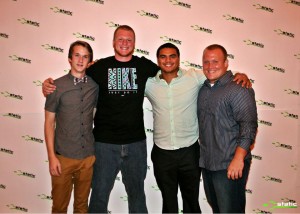Not sure what to do with your kids when they get bored and start taking it out on you? The Children’s Museum of Siouxland is here to help (eventually).
The Children’s Museum’s purpose is, according to their website, “to provide an interactive learning environment that will serve the needs of our children, families, schools and community. Through hands-on participatory exhibits and innovative programs, the museum will seek to foster imagination and creativity while inspiring life-long learning.”
Through a service learning opportunity provided by the Public Relations course offered here at Morningside, I was able to contribute to raising awareness of this up-and-coming local, non-profit organization.
“Part of a students’ grade for this course was to develop a complete public relations campaign for a Siouxland nonprofit organization,” said the course’s instructor, Lesley Bartholomew.
“[Jordan’s] group chose to work with the Children’s Museum, and I thought that was an interesting opportunity.”
Divided into groups of three, the class’s mission was to generate and present a public relations campaign to the local non-profit organization that we chose. My group, which included two very attractive young women both recently wed –not to each other- and myself, planned to raise awareness to attract interest and donors for the museum.
Thousands of dollars have been donated to the museum, but it is still not yet in operation. The mildly anticipated opening day for the museum is set for some time in February of 2014.
“Our donors have been so generous to have gotten us this far. We’re hoping that around this time next year we will have a location built,” said the museum’s Human Resources Director, Kari Kellen.
“Plans for the museum have been in the works for a while, for a little over 10 years now.”
The Children’s Museum is a potential rec-sensation for the community of Sioux City but has had problems getting people informed of its existence, most likely because it has yet to break ground. That’s where my campaign group comes in. The importance of having a children’s museum as a part of the community is greater now that the population of Sioux City is projected to continually increase by hundreds each year.
“The Children’s Museum is a great place for parents to bring their young, even infant children for a wholesome day of family fun through hands-on activities and exhibits that kids just love,” said Kellen.
“With all of the cool stuff the museum is going to have, I think even I would have fun there and I’m 27 years old,” said Lindze Hass, one of my two fellow group members.
Our group strategy to help the museum was to have informational brochures or pamphlets available in 75% of local public schools and pre-schools. I even created a recorded PSA-style advertisement that could be submitted to local radio stations as the date to open the museum’s doors approaches.
“This place is going to be so cool when it finally opens,” said our third group member, Sarah Feuchtenberger. “It feels good to help the museum spread the word and be more recognized. I’m excited to check it out when they finally open their doors.”
Places like the Children’s Museum of Siouxland are underappreciated for the service that they provide a community. In a world dominated by technology and social media, do we want our children to grow up without the activities that sparked our imagination and creativity when we were kids? Imagine a childhood spent in front of a computer screen instead of finger-painting, petting zoos, and most of all physical contact with other children in your age group. Judging by how society has evolved to revolve around technology, places like the Children’s Museum of Siouxland will be few and far between.




